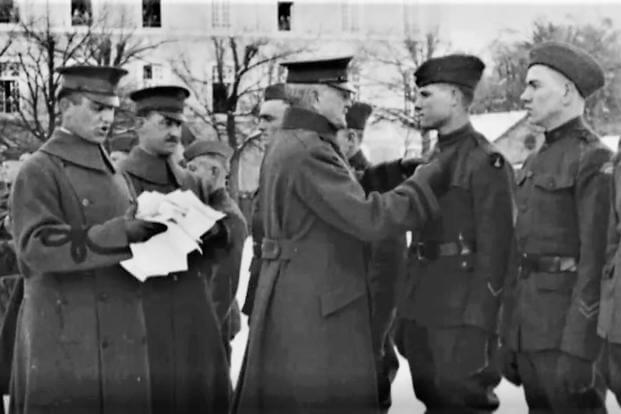Charles Barger's life began under difficult circumstances and never really got any easier.
Born into a notorious Kansas crime family, Barger was put up for adoption when his father was imprisoned for murder, then was orphaned as a boy when his adoptive parents died. He quit school after the fourth grade and tried to support himself with farm jobs for a while before registering for the draft in 1917 -- the year the United States entered World War I.
"The only constants in his life, it seemed, were hard work, poverty and loneliness," retired Air Force Master Sgt. Joseph Bowman wrote in his 2018 book, "Quietly Exploding: The Life of Medal of Honor Hero Charles Barger."
A distant nephew of Barger's father, Bowman learned about him while researching his family's genealogy. Charles' grandson, Joseph A. Barger, and Chris Kraft, the soldier's cousin, helped Bowman fill in myriad blanks, and what they discovered was incredible.
Read Next: New Graphic Novel Spotlights Robert Smalls, Who Escaped Slavery on a Stolen Confederate Ship
Barger's birth parents were George and Cora Staffelbach. George's mother, Nancy, ran a brothel, and along with her three sons, she often ran afoul of the law. The Staffelbachs started with petty offenses before graduating to more serious crimes, including murder. Their exact number of victims is unknown, but the Staffelbachs generally followed a familiar pattern: They would target a man visiting the brothel, rob and kill him, and dump his corpse down an abandoned mineshaft.

The Staffelbachs' reign of terror ended in 1897 when a stranger discovered a decomposed body floating in a mineshaft, according to "Quietly Exploding." Nancy, George and another son, Ed, were convicted of the crime, and shortly after the trial, Cora divorced George and placed Charles up for adoption. The boy was either 3 or 4 when the Bargers -- an elderly farm couple seeking help with chores more than someone to raise in a loving home -- took him in. As soon as Charles was old enough, he worked nearly every day.
After the Bargers died, Charles was on his own. He stopped going to school and worked full time, but basic necessities usually eluded him. At least when he joined the Army, Barger didn't have to worry about his next meal, where he would sleep at night or whether he would have enough clothes to wear.
Arriving in France in 1918, Barger became an automatic rifle gunner. It was not uncommon for the 24-year-old soldier to accept dangerous assignments such as going on fighting patrols or raiding parties, Bowman wrote in "Quietly Exploding." Barger quickly revealed a fearless streak -- one exemplified at St. Mihiel, when he volunteered to retrieve a dead soldier's body. Barger not only successfully completed that mission, but also returned with five German POWs and two enemy machine guns.

That incident served as a prelude to the action that earned Barger and his assistant gunner, Jesse Funk, the Medal of Honor. Six weeks after the St. Mihiel Offensive, Barger and the rest of the 354th Infantry Regiment, 89th Division were involved in the largest American operation of World War I. The Meuse-Argonne Offensive began on Sept. 26, 1918, and lasted until the armistice was signed on Nov. 11. During that period, U.S. forces deployed more than 1 million soldiers and sustained more than 26,000 deaths and roughly 120,000 casualties.
On Oct. 31, the Germans ambushed two daytime patrols near Bois-de-Bantheville, leaving 2nd Lt. John Millis and 1st Lt. Ernest Rowell severely injured and easy targets for enemy fire. After volunteering to rescue the officers, Barger and Funk began their perilous 500-yard journey into No Man's Land. Crouching and zigzagging as they went, they had few options to protect themselves.
"A bullet spun my helmet halfway around, and I felt one tear through my first-aid packet," Barger recounted, according to "Quietly Exploding." "One [hit] my pistol, and another slapped me across the kneecap and I nearly went down. Jesse was getting every bit as much as I was."
They encountered the injured men a football field away from a nest of four German machine guns. After Millis insisted they rescue Rowell first, Barger and Funk placed the first lieutenant on a stretcher and reversed course, miraculously avoiding being hit despite their clothing being torn to rags by gunfire. They then went back for Millis, navigating their way through a field "filled with ricocheting bullets and unadulterated pandemonium." During those frantic moments, they noticed another injured man, Pvt. Philip Montoya, in need of help, so after returning Millis to safety, they went back for Montoya as well.

Gen. John Pershing, commander of the American Expeditionary Forces, presented Barger and Funk with the Medal of Honor on Feb. 9, 1919, in Chaumont, France.
After the war, Barger struggled in his transition back to civilian life. He battled the effects of exposure to mustard gas, post-traumatic stress and depression. He found work for a decade as a police officer, but was plagued sometimes by a lack of self-control and accused of domestic violence, including allegedly threatening his wife's life.
Often beset by financial troubles, Barger struggled to put food on his family's table, once lamenting, "It's fine to have all the medals, but the trouble is, you can't eat them." Further exacerbating those issues, the Veterans' Administration repeatedly denied benefits claims on Barger's behalf for post-traumatic stress -- a condition that often went undiagnosed at the time.
Barger's condition grew so dire that he spent two years in a mental hospital and tried to kill himself at least once. His burden finally became too unbearable on Nov. 23, 1936, when he set his farm on fire and approached police while wielding a knife during a standoff. An officer shot Barger, suffering from serious burns and self-inflicted stab wounds, in the leg.
The Medal of Honor recipient died two days later and was buried with full military honors.
"He'd never had much of a chance in life," Funk said of his friend after the war. "... Believe me, he sure had grit and I'm proud to have been the running mate of a man that had as much fight in him as he had."
Veterans and service members experiencing a mental health emergency can call the Veteran Crisis Line, 988 and press 1. Help also is available by text, 838255, and via chat at VeteransCrisisLine.net.
Want to Know More About the Military?
Be sure to get the latest news about the U.S. military, as well as critical info about how to join and all the benefits of service. Subscribe to Military.com and receive customized updates delivered straight to your inbox.














